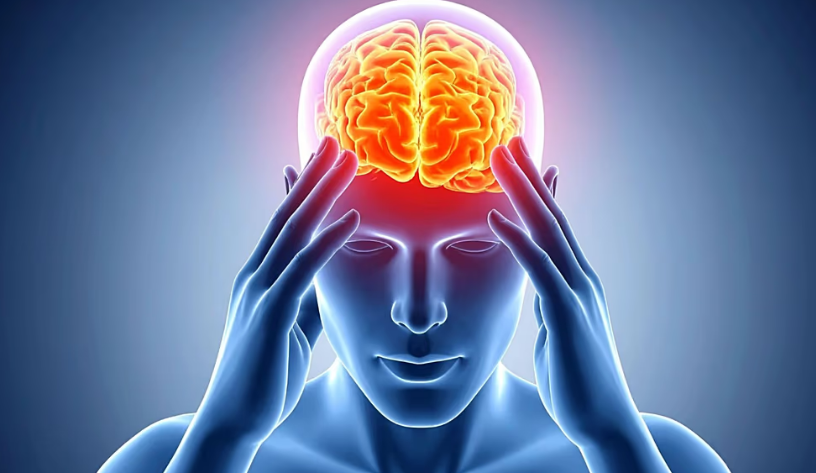Health
Men’s Brains Shrink Faster with Age, But Alzheimer’s Still Strikes Women More Often, Study Finds

Men experience faster brain shrinkage as they age than women, yet Alzheimer’s disease remains nearly twice as common in women, according to a new study that challenges long-held assumptions about the roots of the gender gap in dementia.
The research, published this week in the Proceedings of the National Academy of Sciences (PNAS), examined more than 12,000 brain scans from nearly 5,000 healthy individuals aged 17 to 95. The findings show that while men’s brains show a steeper rate of decline across several key regions, this does not explain why women are far more likely to develop Alzheimer’s disease.
According to the World Health Organization (WHO), around 57 million people were living with dementia in 2021, with nearly 10 million new cases recorded annually. Alzheimer’s disease — the most common form of dementia — disproportionately affects women, with one in five developing the disease by age 45, compared to one in ten men.
For decades, scientists have sought to determine whether structural differences in how male and female brains age could explain this disparity. However, the new study suggests otherwise.
Researchers found that men’s brains tend to shrink faster in multiple regions linked to memory, sensory processing, and movement. The postcentral cortex — the part of the brain that processes sensations such as touch and pain — declined by 2% per year in men, compared to 1.2% in women. Men also exhibited greater thinning in the cerebral cortex, particularly in regions tied to memory and visual recognition, such as the parahippocampal and fusiform areas.
Additionally, men showed more pronounced decline in subcortical structures including the putamen and caudate, which are critical for movement control. Women, by contrast, showed more fluid accumulation in the brain’s ventricles — a sign of normal ageing — but retained more structural integrity overall.
Despite this, women continue to face a far higher risk of Alzheimer’s disease. Experts say the reasons lie beyond structural brain changes, pointing instead to hormonal, genetic, and lifespan factors.
“Hormonal changes after menopause, vascular and immune differences, and genes like APOE ε4 all play a role,” said one of the study’s authors. “Women also live longer than men, which naturally increases their risk.”
Globally, women’s life expectancy is about five years longer than men’s — 73.8 years versus 68.4 years in 2021 — meaning more women live into the age range where Alzheimer’s risk is highest.
The findings underscore the complexity of Alzheimer’s and the need to explore biological and environmental factors beyond simple brain volume loss. As the researchers concluded, the key to understanding women’s greater vulnerability to dementia “will not be found in brain scans alone.”
Health
Sperm Donor with Cancer-Causing Mutation Fathers Nearly 200 Children Across Europe

A sperm donor carrying a rare cancer-causing genetic mutation has fathered nearly 200 children across Europe, according to an investigation led by the European Broadcasting Union, involving 14 public service broadcasters. The man, who appeared healthy and passed standard screening, donated sperm for approximately 17 years while he was a student.
The mutation, found in the TP53 gene, increases the risk of cells becoming cancerous. Children who inherit the mutation develop Li Fraumeni syndrome, a disorder associated with up to a 90 percent lifetime risk of cancer. Some donor-conceived children have already died, and many more are expected to develop cancer in the future.
Doctors first identified the risk this year after discovering 23 children carrying the mutation among 67 known cases, 10 of whom had already been diagnosed with cancer. Investigators reported that the donor’s sperm was used to conceive at least 197 children in 14 countries, though the actual number may be higher. Children have been born in Denmark, Belgium, Spain, Greece, and Germany, with additional recipients in Ireland, Poland, Albania, Kosovo, and Sweden. A small number of women from the United Kingdom were also treated at clinics in Denmark, according to Peter Thompson, chief executive of the UK’s Human Fertilisation and Embryology Authority.
Denmark’s European Sperm Bank, which supplied the samples, admitted the sperm was overused and expressed “deepest sympathy” to affected families. The bank said the mutation could not have been detected through routine screening and immediately blocked the donor once the problem was discovered.
Experts have described the case as both a regulatory failure and an extraordinary coincidence. Jackson Kirkman-Brown, a professor at the University of Birmingham, noted that detecting new mutations in sperm is difficult and that the core issue lies in insufficient monitoring of how often a single donor’s sperm is used. Clare Turnbull from the UK Institute of Cancer Research said the situation reflects a highly unusual combination: a donor carrying a rare mutation and that same sperm being used to create a large number of children. She added that the mutation likely arose in the donor’s testes and spread among sperm cells, a phenomenon known as selfish spermatogonial selection.
The investigation has also highlighted differences in European regulations on sperm donation. Family and child limits vary widely: in Cyprus, a donor may contribute to only one child, while France, Greece, Italy, and Poland allow up to 10. Denmark limits donations to 12 families, and Sweden and Norway to six families. Some countries maintain anonymous donations, though disclosure may occur in cases of severe health conditions.
Euronews Health has contacted the European Sperm Bank for comment but has not yet received a response. The case has renewed calls from experts for tighter international oversight of sperm donation to prevent similar incidents in the future.
Health
AI Note-Taking Tool Gives European Clinicians More Time With Patients, Study Finds

A new analysis from Swedish firm Tandem Health suggests that automated note-taking technology is reducing paperwork for clinicians across Europe and allowing them to spend more meaningful time with patients.
The company reviewed more than 375,000 medical notes produced with its AI scribe, a tool now used by nearly 1,300 clinicians in 11 European countries, including the UK, France and Spain. The findings indicate that the technology shortened the average time spent writing notes from 6.69 minutes to 4.71 minutes — a 29% drop.
Tandem Health also surveyed 177 clinicians, ranging from GPs and surgeons to psychologists and nurses. Many said the reduction in administrative work allowed them to feel more attentive during consultations, while some reported a noticeable decrease in stress linked to routine documentation.
Health workforce fatigue remains a growing concern in Europe. An international survey published earlier this year found that administrative overload is a major factor behind burnout among primary care doctors. In the UK, 28% of GPs who reported burnout said excessive paperwork was the main cause. In Switzerland, the proportion rose to 65%.
Tandem Health CEO Lukas Saari said the results highlight how digital tools could support overstretched services. “For European healthcare systems facing acute workforce shortages and rising costs, that capacity gain could make a real difference at scale, addressing wait times, clinician burnout and care access,” he said.
The company stressed that much of the existing research on AI scribes comes from the United States, where healthcare structures differ significantly from those in Europe. Tandem Health’s scribe is classified as a medical device under EU rules, and the firm says more regional evidence is necessary as adoption grows.
Dr Artin Entezarjou, head of medical operations at Tandem Health, said the data offers insight for policymakers and health leaders examining new ways to address persistent staffing pressures. He noted that European systems must understand how such tools function in their own clinical environments to shape appropriate guidance and investment decisions.
Supporters of the technology argue that even modest efficiency gains could help reduce appointment backlogs and ease strain on health workers. Many clinicians in the survey said the extra time and reduced cognitive load improved the quality of their patient interactions, which they viewed as a central benefit of the scribe.
The findings arrive as hospitals and primary care networks across Europe continue to test digital tools that could take on repetitive administrative duties. Tandem Health says demand for its scribe has risen sharply over the past year as more clinicians explore ways to streamline paperwork without compromising record accuracy.
The company plans to expand data collection to assess long-term effects on patient flow, clinical workload and staff retention.
Health
Global Study Finds Sleep May Play Greater Role Than Exercise in Overall Health

A major international study has found that only a small share of people manage to meet recommended levels of both sleep and daily physical activity, raising new questions about long-standing health guidelines and how people can realistically follow them.
The research, published in the journal Communications Medicine, analysed data from wearable sleep and activity trackers from more than 70,000 people across multiple regions over a period of three and a half years. The findings show that only about 13 per cent consistently achieved the commonly promoted targets of seven to nine hours of sleep each night and at least 8,000 steps per day.
Lead author Josh Fitton, a sleep researcher at Flinders University in Australia, said the results highlight the gap between public health recommendations and everyday routines. “Only a tiny fraction of people can achieve both recommended sleep and activity levels every day, so we really need to think about how these guidelines work together and what we can do to support people to meet them in ways that fit real life,” he said.
The study revealed that people often manage to either get sufficient rest or maintain an active routine, but struggle to sustain both. Nearly 17 per cent of participants averaged fewer than seven hours of sleep and fewer than 5,000 steps daily, placing them in what researchers described as a “sedentary” group. This combination has been linked in past studies to a higher likelihood of chronic illness, weight gain and mental health issues.
Researchers noted that the data has limitations, as tracking devices tend to be more commonly used in higher-income countries, potentially skewing the global representation. Even so, the analysis uncovered a consistent pattern across participants: those who slept between six and seven hours a night recorded the highest number of steps the next day.
Senior author Danny Eckert, also from Flinders University, said the findings suggest that sleep may play a stronger role than many realise in shaping daily energy and activity levels. “Prioritising sleep could be the most effective way to boost your energy, motivation, and capacity for movement,” he said.
He added that small adjustments can help people build healthier routines. This includes reducing screen exposure before bed, maintaining regular sleep schedules and creating calming nighttime environments to support better rest.
The study’s authors say the results point to a need for clearer and more practical guidance, especially for people who struggle to balance work, family responsibilities and personal health goals. They say that for many, improving sleep habits may be the most realistic first step toward leading more active and healthier lives.
-

 Entertainment1 year ago
Entertainment1 year agoMeta Acquires Tilda Swinton VR Doc ‘Impulse: Playing With Reality’
-

 Business2 years ago
Business2 years agoSaudi Arabia’s Model for Sustainable Aviation Practices
-

 Business2 years ago
Business2 years agoRecent Developments in Small Business Taxes
-

 Home Improvement1 year ago
Home Improvement1 year agoEffective Drain Cleaning: A Key to a Healthy Plumbing System
-

 Politics2 years ago
Politics2 years agoWho was Ebrahim Raisi and his status in Iranian Politics?
-

 Business1 year ago
Business1 year agoCarrectly: Revolutionizing Car Care in Chicago
-

 Sports1 year ago
Sports1 year agoKeely Hodgkinson Wins Britain’s First Athletics Gold at Paris Olympics in 800m
-

 Business1 year ago
Business1 year agoSaudi Arabia: Foreign Direct Investment Rises by 5.6% in Q1


























